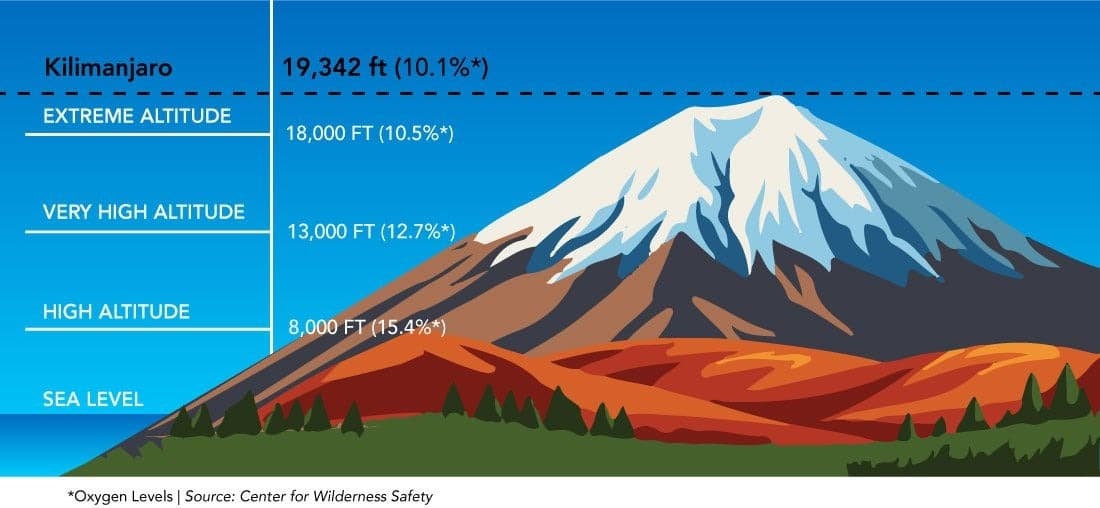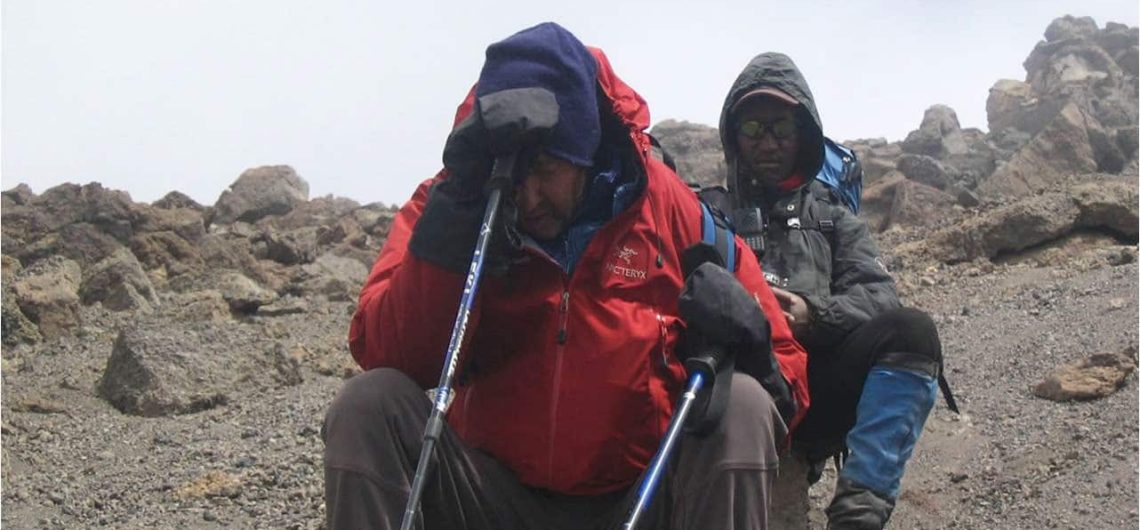Breathing difficulty on Kilimanjaro does not affect everyone as long as you acclimatize properly. Yes, oxygen gets thinner as you climb up to the summit of Kilimanjaro but you are ok on the lower slopes and some people start feeling mild symptoms of altitude sickness past halfway the mountain. For day hikes, we have never heard of any complaints because we always hike below the elevation where altitude sickness becomes an issue for some climbers. Mount Kilimanjaro, located in Tanzania, is the tallest mountain in Africa and the world’s highest freestanding mountain, standing at 5,895 meters (19,341 feet) above sea level. It attracts 30,000 to 50,000 climbers annually from around the globe. While many dream of reaching the summit, one common question arises: Is it hard to breathe on Kilimanjaro?
Just like in the Marathons, maintain a slow and steady pace, and control your breathing to avoid stressing your heart and lungs, drink a lot of water and watch for the symptoms, our mountain guides will be with you all the way of course. We always carry an emergency supplemental oxygen bottle, when the symptoms become severe we will do all we can to get you to come down from the mountain. This not only applies to climbing Kilimanjaro but also Mount Kenya, Rwenzori and Mount Meru.
As the air gets dry as you ascend to the higher camps, you might have some trouble sleeping (for some people) due to oxygenation and the diagram below shows the oxygen levels for the different elevations on the mountain.

What is High Altitude?
To understand how Kilimanjaro affects breathing, it’s important to know what high altitude means. High altitude is defined as any elevation above 2,500 meters (8,200 feet). This oxygen reduction can make breathing more difficult. At the summit of Kilimanjaro breathing at the peak is compared to using only one lung to inhale and exhale as oxygen becomes thinner and thinner and decreases, the higher you go.
Why is Breathing Harder at High Altitudes?
One of the most common challenges at high altitudes is shortness of breath. Because the air is thinner, each breath you take contains less oxygen than at sea level. In response, your body tries to compensate by breathing faster and deeper to get more oxygen. Despite this, you may still feel out of breath, even when doing simple tasks like walking or resting.
Shortness of breath is a normal reaction to high altitude and doesn’t always signal a problem. At high elevations like Kilimanjaro’s, each breath delivers less oxygen, prompting faster and deeper breathing. This can lead to feeling breathless, even with little exertion. While this is a normal reaction, persistent or worsening breathlessness might indicate altitude sickness. To
Acclimatization: The Key to Adjusting
The best way to handle the thin air on Kilimanjaro is through acclimatization—the process by which your body adjusts to lower oxygen levels at higher altitudes. It typically takes one to three days for the body to acclimatize, and climbers are encouraged to ascend gradually to give their bodies time to adjust.
Here are some ways to support acclimatization:
- Hydrate: Drink plenty of water to help your body function properly.
- Eat well: A balanced, high-carbohydrate diet helps provide the energy needed to climb.
- Avoid alcohol and strenuous activities: These can strain your body, making it harder to adjust to altitude.
Some climbers take medication like Diamox to help speed up acclimatization. It’s important to consult a doctor before taking any medication to make sure it’s safe for you.
What is Altitude Sickness?
Altitude sickness, also known as acute mountain sickness (AMS), occurs when your body cannot acclimatize properly to high altitude. Failing to acclimatize can lead to altitude sickness, with severe forms like HAPE and HACE being potentially fatal. Symptoms include extreme breathlessness, fatigue, and dizziness, requiring immediate descent and medical attention. In severe cases, it can develop into life-threatening conditions such as:
- High Altitude Pulmonary Edema (HAPE): Fluid builds up in the lungs.
- High Altitude Cerebral Edema (HACE): Fluid builds up in the brain.
Symptoms of altitude sickness include:
- Severe shortness of breath
- Dizziness or confusion
- Fatigue or weakness
- Loss of appetite
If you experience these symptoms, it’s important to notify your guide immediately. The best treatment for altitude sickness is descending to a lower altitude.
The Science of Oxygen Levels at Kilimanjaro’s Summit and Other High Altitudes
The oxygen levels at Uhuru Peak, the peak of Kilimanjaro, which is roughly 5,895 meters above sea level, are almost 50% lower.
The peak of Mount Kilimanjaro has almost half as much as sea level.
What Causes the Lower Oxygen Levels on Kilimanjaro?
Higher elevations cause the atmospheric pressure to drop, which in turn lowers the quantity of oxygen your body can absorb.
In other words, the air has less oxygen the higher you go. This phenomena applies to all high-altitude sites and is not specific to Mount Kilimanjaro.
How Does the Lower Oxygen Level at Mount Kilimanjaro Affect Travellers?
Your body’s ability to adjust to high-altitude situations is greatly influenced by arterial blood gases. These gases—more especially, carbon dioxide and oxygen—indicate how well and how hard your respiratory system is functioning.
At higher elevations, your body must use more effort to deliver oxygen to your tissues and organs, which, if left unchecked, can cause weariness and other symptoms.
Anyone thinking about climbing Mount Kilimanjaro needs to understand the science behind oxygen levels at high altitudes; it’s not simply academic.
Understanding these elements will enable you to plan more effectively and make wiser choices, guaranteeing a more secure and pleasurable journey.
Because dehydration can exacerbate altitude sickness symptoms, it’s critical to stay hydrated.
The Reality of Altitude Sickness
Trekkers who are going to the summit of Mount Kilimanjaro frequently worry about altitude sickness, so you should take it seriously.
Headaches, nausea, dizziness, and shortness of breath are common signs of altitude sickness, which can range in severity from mild to severe. In more severe situations, you can feel exhausted, sleep deprived, and throw up.
These symptoms typically appear at elevations higher than 8,000 feet, and they can get worse if you climb too fast without allowing your body to adjust.
The majority of visitors reported feeling some kind of altitude sickness when at 5,895-meter Uhuru Peak, according to U.S. News & World Report.
Given the substantial decline in oxygen levels at such high elevations, this is not surprising.
In order to avoid symptoms, it’s important to pay attention to your body and take precautions like climbing gradually, drinking plenty of water, and thinking about taking drugs like acetazolamide, also marketed as Diamox.
Physical Dangers and Health Risks
Knowledge is your best defense against the health and physical hazards that come with high-altitude walking.
The most prevalent type of altitude sickness is Acute Mountain Sickness (AMS). It is frequently the initial indication that your body is having trouble adjusting to the lower oxygen levels on Mount Kilimanjaro.
Fatigue, nausea, and headaches are among the symptoms. You must stop climbing and give yourself time to acclimate if you encounter these symptoms.
Ignoring altitude sickness can have serious consequences, including the development of life-threatening diseases like high-altitude cerebral oedema (HACE) or high-altitude pulmonary oedema (HAPE), both of which necessitate prompt medical attention and descent.
A potentially fatal illness called HAPE causes fluid to build up in the lungs, making breathing challenging.
HACE, on the other hand, is a buildup of fluid in the brain that causes confusion and, if left untreated, coma or death. Medical intervention and rapid descent are necessary for both cases.
These hazards can be reduced and your expedition can become the best it can be with the right equipment and planning.
Essentials like warm clothing, good boots, and—above all—a dependable oxygen supply for higher elevations should be part of your equipment. Therefore, carefully consider what you include on your packing list for Kilimanjaro treks.
Physical training to increase your stamina and cardiovascular fitness as well as mental preparation to manage the psychological strains of high-altitude hiking are further components of preparedness. At least three months prior to your trip, begin your Kilimanjaro climb preparations.
Remind yourself that while reaching Uhuru Peak is an amazing accomplishment, it is not worth putting your life in danger for.
For a successful and safe hike, having the right equipment and being prepared are essentials, not extras. Being ready can be the difference between a scenario that could change your life and one that could endanger it.
Choosing a Reputable Tour Operator
To ensure your safety on Kilimanjaro, it’s essential to choose a reliable tour operator like us, Tranquil Kilimanjaro. Experienced guides are trained to spot the symptoms of altitude sickness and help climbers manage their breathing at high altitudes. They also plan the trek with acclimatization breaks to give you the best chance of reaching the summit safely.
Our thoughts
So, is it hard to breathe on Kilimanjaro? Yes, due to the thinner air at high altitudes, breathing can be more difficult. However, with proper acclimatization and preparation, most climbers can manage it successfully. Climbing Kilimanjaro is a physically demanding challenge, but it’s also incredibly rewarding. Training before the climb, pacing yourself, and listening to your body will help you safely enjoy this unforgettable experience.
If you’re ready to take on Kilimanjaro, make sure to plan carefully, choose a trusted tour operator, and prepare yourself physically for the adventure of a lifetime. Start planning your trek today!
- Training with an Altitude Mask: Does it Help in Climbing Kilimanjaro?
- Debunking the popular Myths About Altitude
- How to overcome the fear of heights if you are afraid of high altitudes
- 5 Medications that Help in Acclimatization & Combat Altitude Sickness
- Altitude Sickness: Mount Kenya
- How Long Does It Take to Recover From Climbing Kilimanjaro?
- How hard is climbing Kilimanjaro?
- How fit do I need to be to climb Kilimanjaro?
![]()

